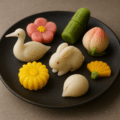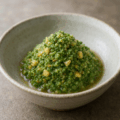さんまのすり身汁(岩手)の特徴
三陸の秋の恵みを丸ごと味わう、ふんわりつみれの一椀
さんまのすり身汁は、三陸沿岸を中心に親しまれてきた郷土料理です。新鮮なさんまをすり身にしてふんわりとしたつみれに仕立て、根菜やきのこと一緒にだしでやさしく煮含めます。味噌仕立てのやわらかな風味に、しょうがやねぎの香りが心地よく広がります。
味噌ベースが基本、具材と薬味で季節感を重ねます
仕立ては味噌が主流ですが、家庭によりしょうゆで風味を締めることもあります。大根・ごぼう・きのこ・こんにゃくなどと相性が良く、仕上げにせりやゆず皮を添えると香りが引き立ちます。
さんまのすり身汁(岩手) レシピ
材料(5人分)
- 生さんま(三枚おろし) … 3尾(正味約400g)
- 人参…200g(短冊切り)
- 大根 … 200g(いちょう切り)
- 長ねぎ … 1/2本(小口切り)
- だし … 1,000ml(昆布+煮干し、または昆布+かつお)
- しょうが … 10g(すりおろし)
- 卵白 … 1個分
- 片栗粉 … 大さじ1
- みそ(練り地用) … 小さじ2
- みそ(仕上げ用) … 60〜80g
- 酒 … 大さじ2
- しょうゆ … 小さじ1(風味調整)
- 塩 … 少々
作り方
- 1. さんまは腹骨と血合い骨を除き、皮を外して粗く刻む。包丁で叩くかフードプロセッサーでミンチにする。
- 2. すり身にしょうが・卵白・片栗粉・みそ(練り地用)・塩少々を加え、粘りが出るまで練る。冷蔵で10分休ませる。
- 3. 鍋にだしを沸かし、大根・人参を入れて中火で7〜8分煮る。
- 4. 休ませたすり身をスプーンで一口大に丸め、静かに鍋へ落とす。弱めの中火で3〜4分、浮いて火が通るまで煮る。
- 5. 酒・しょうゆで風味を整え、火加減を弱めてみそ(仕上げ用)を溶き入れる。
- 6. 味を見て塩で調えたらネギを加え、器によそう。
シェフのワンポイントアドバイス
- すり身はしっかり練るほどふんわりまとまります。煮立て過ぎず静かに火を通すと臭みが出にくいです。
- さんまが手に入りにくい時期は、いわしでも代用できます。
栄養価(1人分の目安)
- エネルギー … 180〜260 kcal
- たんぱく質 … 18〜24 g
- 脂質 … 7〜12 g
- 炭水化物 … 8〜15 g
- オメガ3脂肪酸・ビタミンD … さんま由来
歴史
三陸の漁と台所が育んだ“すり身の知恵”です
豊かなさんま漁を背景に、骨や小骨を活かすすり身づくりが家庭に根づきました。味噌仕立ての澄んだだしに季節の野菜を合わせる食べ方が受け継がれています。かつては岩手県はサンマの漁獲量がNO1でしたが、現在は漁獲量が減った為、いわしで代用しています。
秋の行事や浜のまかないから家庭の味へ
水揚げ時季のまかないや地域の集まりで振る舞われ、家庭の定番として広がりました。薬味や具の取り合わせは家ごとに個性があり、季節の香りを映します。
English Version
Features of Sanma Fishball Soup (Iwate)
A bowl of fluffy fish balls capturing Sanriku’s autumn bounty
Beloved along the Sanriku coast, this soup turns fresh Pacific saury into tender fish balls simmered gently with root vegetables and dashi. A mellow miso base carries soothing notes of ginger and green onion.
Miso-led seasoning, with vegetables and aromatics for the season
Miso is standard, with some homes adding a touch of soy sauce for finish. Daikon and carrot pair well; the soup is lifted at the end with sliced negi and, in some households, yuzu peel or herbs.
Sanma Fishball Soup (Iwate) – Recipe
Ingredients (Serves 5)
- Pacific saury, filleted … 3 fish (net ≈ 400 g)
- Carrot … 200 g (thin short strips)
- Daikon … 200 g (half-moon slices)
- Long green onion … 1/2 stalk (finely sliced)
- Dashi … 1,000 ml (kombu + niboshi, or kombu + katsuobushi)
- Ginger … 10 g (grated)
- Egg white … 1
- Potato starch … 1 Tbsp
- Miso (for fish paste) … 2 tsp
- Miso (to finish) … 60–80 g
- Sake … 2 Tbsp
- Soy sauce … 1 tsp (to adjust flavor)
- Salt … a pinch
Directions
- 1. Remove belly and pin bones from the saury, skin, and roughly chop; mince with a knife or food processor.
- 2. Mix minced fish with ginger, egg white, potato starch, miso (for paste), and a pinch of salt until sticky; chill 10 minutes.
- 3. Bring dashi to a boil; add daikon and carrot and simmer 7–8 minutes over medium heat.
- 4. Scoop paste into bite-size balls and slide into the pot; simmer gently 3–4 minutes until they float and are cooked through.
- 5. Season with sake and soy sauce; lower heat and dissolve in miso (to finish).
- 6. Adjust salt, add the sliced green onion, and ladle into bowls.
Chef’s Tips
- Knead the paste well for a fluffy texture; keep the simmer gentle to avoid fishy notes.
- If fresh saury is hard to find, sardine makes a good substitute.
Nutrition (per serving, approx.)
- Energy … 180–260 kcal
- Protein … 18–24 g
- Fat … 7–12 g
- Carbohydrates … 8–15 g
- Omega-3 fatty acids & vitamin D … primarily from saury
History
Surimi know-how from Sanriku fisheries and home kitchens
With rich saury harvests, households embraced mincing and shaping fish into tender balls, simmering them in clear miso broth with seasonal vegetables.
From autumn work meals to a family favorite
Once served at landing seasons and local gatherings, the soup became a home staple. Iwate was long known for abundant saury; with recent declines in landings, some families now substitute sardine, while keeping the same gentle, seasonal accents.



何でも質問してください!